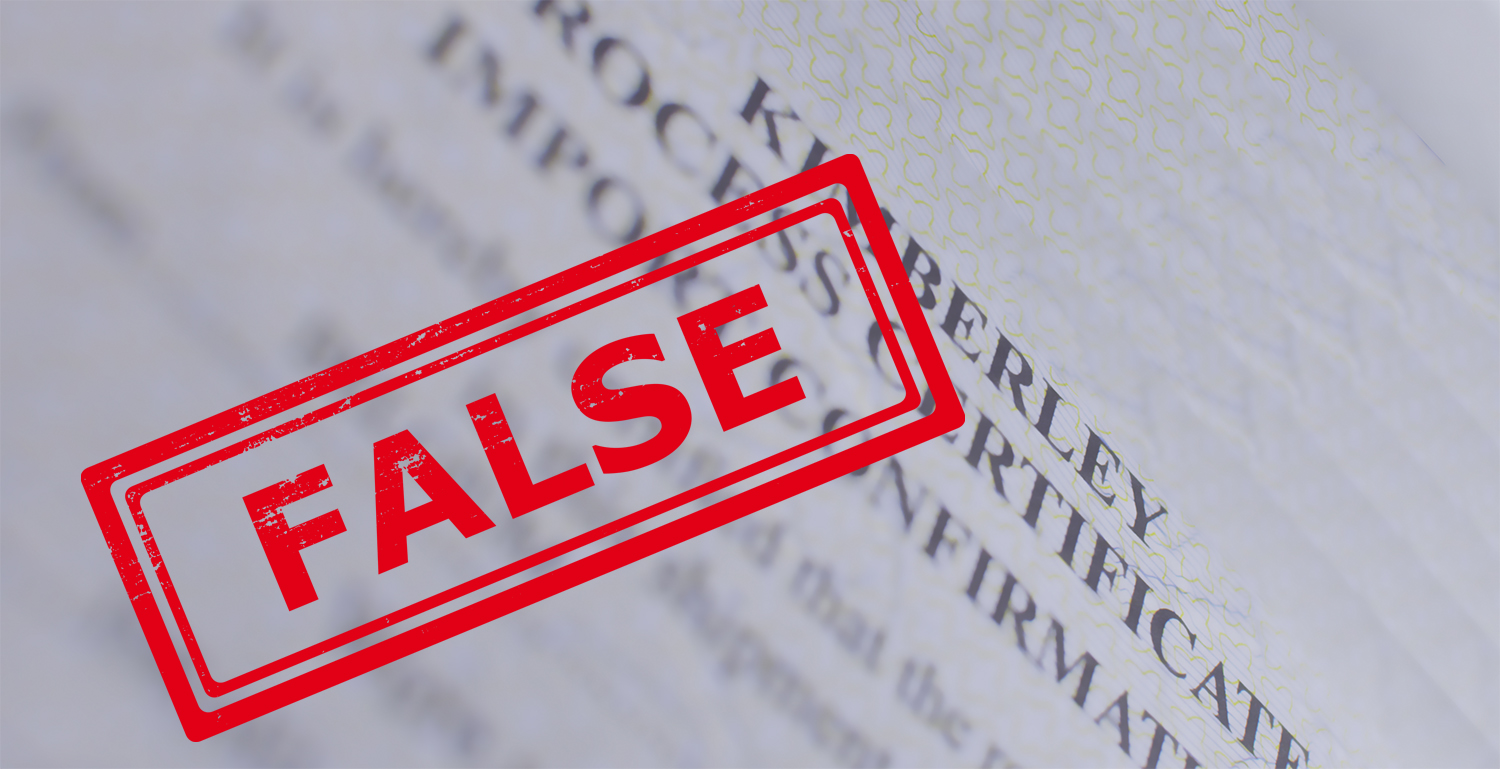ALTHOUGH FALSE KP CERTIFICATES ARE RARE,
INDUSTRY CAUTION IS STILL RECOMMENDED


Mark Van Bockstael
By Mark Van Bockstael
Chair, KP Working Group of Diamond Experts
Chairman, WDC Technical Committee
Several times a year, with uncanny regularity, the international diamond trade receives alerts from the Kimberley Process (KP) about yet another false certificate that has been encountered, and for which it is asked to practice enhanced vigilance. Together with the mostly negative media coverage such news generates, many diamantaires wonder whether the Kimberley Process Certification Scheme (KPCS) is still functional, remaining capable of delivering on the mandate that KP received from the United Nations in 2000, of breaking the link between armed conflict and the diamond trade.
How gloomy this all may seem. But the truth is that the KPCS is still very much alive and effective. The occasional alert that is issued is real, but is not really indicative of the overwhelming majority of legitimate KP certificates.
A few figures will clarify this statement:
- The official KP website shows that seven alerts about false KP certificates were broadcast in 2015, out of a total of 53,738 KP certificates issued worldwide. This represents a rate of just 0.013 percent.
- The same KP website shows 16 alerts each for false KP certificates in 2016, 2017 and 2018 on total issued of 61,793, 70,278 and 64,097 respectively. These compute into rates of 0.026 percent; 0.023 percent and 0.025 percent respectively.
- For the most recent year on record, 2019, the KP website shows that there were seven alerts out of a total of 52,443 KP certificates issued, corresponding to a rate of 0.013 percent.
Clearly, these are very good results. But are they reflective of reality? Some may argue that the low numbers could be the result of very lax oversight, and what we are seeing is akin to the tip of the iceberg. But this is unlikely. The chances are that what the KP reports is pretty close to the truth.
How is it that we are are so confident? What is the mechanism that makes it possible to find the proverbial needle in the haystack – identifying the few false certificates from the giant stack of bonafide ones?
The trick that the KP has up its sleeve is Import Confirmation. It makes all the difference. Every KP certificate accompanying an imported rough diamond shipment from any KP Participant-country must be reported back to the KP authority that issued it at the point of export. Import confirmation is a KP minimum requirement that must be performed at all times.
For this particular purpose, most KP Participant-countries include an especially designed import confirmation section on their outgoing KP certificates. All the importing KP authority then needs to do is check that the contents of the shipment and the KP certificate match, detach the Import Confirmation section from the KP certificate, stamp and countersign it, and then send it back to the issuer.
This way, a closed loop is created between both ends of the international transfer and attempts to defraud are easily identified.

The main purpose of this article, therefore, is to inform diamond dealers about the relevant questions they should ask when doing due diligence, particularly when it involves decisions to buy rough diamonds from sources previously unknown to them.
This is particularly relevant because a large percentage of the false KP certificates are not even physical documents accompanying a shipment of rough diamonds. Indeed, most are digital files viewable only on a computer or mobile-device screen, which were created by criminals posing as genuine, small-scale diamond producers. Generally, they are seeking to defraud an unsuspecting diamantaire, typically with a too-good-to-be-true deal for rough diamonds. When then the diamond dealer requests confirmation of the authenticity of the document from the KP Focal Point in his country, the fraudulent KP certificate is easily identified, and is then added to the official list of false KP certificates that is posted on the KP website.
There are other warning signs that could alert you to the possibility that a KP certificate is indeed false.
- In many of the positive cases, the diamantaires who are the subjects of the sting are not specialized in dealing with rough diamonds. Since they are less familiar with the workings and procedures of the KPCS, the fraudsters consider them an easier mark.
- Generally, false KP certificates identify the purportedly issuing country as one of the smaller diamond-producing nations—and I mean smaller in terms of production totals and not necessarily in terms of physical size. These have included Sierra Leone, Guinea, Liberia and more recently Cameroon and the Republic of Congo (Brazzaville). There seems to be some correlation with how many times these countries have been in mentioned in the media in any particular timeframe, and the number of attempts their identities are used to defraud.
- A more obvious sign is a KP certificate issued from a country that is not a KP Participant-country. Here clearly it is false. In 2015, a KP certificate from Kenya was identified, and Kenya is not a KP Participant. A similar, but possibly less obvious case occurred 2016, when a KP certificate from UK was detected. At the time, the UK was a full-fledged member of the European Union, wish issues certificates on behalf of its member countries. Consequently, the certificate was clearly fraudulent. So please check which countries are members of the Kimberley Process on the official KP website at www.KimberleyProcess.com.
- When the seller proposing a deal already produces a KP certificate before the transaction is concluded, you may assume it most probably is a fraud. The KP certificate can only be issued by a KP Authority of a KP Participant-country when the name and address of the importer – meaning the purchasing dealer – is already known, and in most of the countries only after payment has been transferred in full into a domestic bank account.
If none of these warning signs are present, but you are still uneasy as to whether the KP certificate associated with a shipment is legitimate or not, please contact your country’s KP Focal Point. Alternatively, contact the WDC at info@worlddiamondcouncil.org






